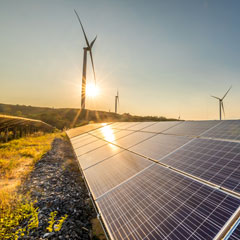
Evaluation Period: 2014 – 2018
Total Awarded: $261,126,150
Total Number of Grants: 131
Geographic Focus: United States, India
Background
The world is experiencing the disruptive effects of climate change. The principal cause is the accumulation of atmospheric carbon dioxide and other heat-trapping substances emitted by the burning of fossil fuels for energy production and the increasing use of land in ways that limit its ability to absorb greenhouse gases. There is scientific consensus that allowing the earth’s temperature to rise more than 2 degrees Celsius above pre-industrial levels will cause significant and ever-increasing negative impacts around the world such as rising seas, severe droughts, and food and water insecurity. Three countries are responsible for a large share of global emissions: United States, China, and India.
Since 2014 the MacArthur Foundation’s Climate Solutions program has invested over $260 million dollars to ensure our goal that global temperature rise stays well below 2 degrees Celsius over pre-industrial levels. Our working theory of change is that the United States, India, and China must lead the world’s efforts to address climate change. Each nation will have its own style, approach, advances and setbacks, and goals; collectively they must ensure a steep decline in current and future greenhouse gas emissions within the next decade. If these three nations exert leadership on climate change, then other nations will be encouraged to follow suit, and humanity will be on a path toward ensuring global temperature rise stays well below 2 degrees Celsius.
What We Evaluated
In 2016, the Foundation engaged Grassroots Solutions to evaluate the Climate Solutions theory of change. At the highest level, the evaluation and learning partner is to answer two big-picture questions:
- How is the Climate Solutions strategy contributing to promoting leadership and climate solutions?
- How are the Climate Solutions strategy and its grantees adapting to work more effectively?
To answer these questions, the evaluation is designed to measure the ultimate contribution of the Climate Solutions program work and progress toward the specified goals of our efforts. It is also designed to better understand the contexts in which the work is taking place and identify and document what is working well and what needs to be adjusted.
Quantitative and qualitative methodologies are used to assess the contribution of the Climate Solutions program and to determine if progress is being made towards desired outcomes in each country-specific context.
What We Learned
The purpose of each annual report is to facilitate learning and decision making. This report builds on the 2014-2017 Climate Solutions Big Bet Baseline and Landscape Report. In the 2018 annual report, Grassroots explores findings about progress towards desired impacts and outcomes, changes in the broader landscape that could help or hinder the Foundation’s work, and, to the extent possible, the contribution of the strategy to larger impacts:
From this report high-level takeaways included:
- The Foundation’s work in the U.S. and India has had a positive effect within the broad ecosystem of climate actors. In the U.S., the Foundation and its grantees influenced the closure of more than 50 percent of U.S. coal fired power plants. As for India, grantees helped strengthen institutional capacity among government agencies and partners within the private sector. In addition, the Foundation’s grantees had a hand in contributing to energy savings through the deployment of clean technology.
- There are several contextual challenges that might affect the Foundations’ progress toward the desired outcomes and impacts in India and the U.S. These include the growing gap in U.S. politics between those on the left and right, which poses a challenge to Foundation grantees who seek to broaden the base of advocates for climate solutions. And while India experienced a 17 percent increase in installed capacity from renewables between 2017-2018, challenges have become more pronounced. For example, the Government of India was preoccupied with tackling the problem of stalled projects and stranded assets within the thermal power sector. This diverted political attention and focus away from a further expansion of renewables.
- The Foundation’s theory of change is sound and continues to be relevant. Findings from the report affirm continued focus on promoting leadership in the U.S., India, and China to achieve the Foundation’s desired long-term impacts and outcomes.
Subsequent reports will continue to report on the progress towards outcomes and impacts and changes in the landscape.
MacArthur’s evaluation philosophy ›



